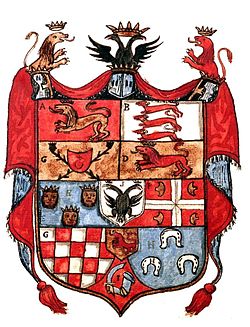| Fojnica Armorial | |
|---|---|
| Bosnia and Herzegovina | |
 The combined coat of arms on the first page of a fictional "Illyrian Empire", based on the one found in the Ohmućević Armorial.
The divisions are labelled with letters as follows: (A) Macedonia, (B) Slavonia, (C) Bosnia (the star-and-crescent of "Illyria" is present in an inescutcheon in the Bosnian coat of arms), (D) Bulgaria, (E) Dalmatia, (F) Serbia, (G) Croatia, (H) Rascia, (I) "Primordia", with an added imperial double-headed eagle (labelled J) | |
| Date | Uncertain |
| Scribe(s) | Stanislav Rubčić |
| Dedicated to | King Stefan Dušan |
| Script | Cyrillic |
| Contents | Heraldry; 139 coats of arms |
| Exemplar(s) | 1 |
| Previously kept | Franciscan monastery in Fojnica |
| Discovered | 1800 |
Fojnica Armorial (Serbo-Croatian: Fojnički grbovnik, Фојнички грбовник) is a prominent Illyrian armorial which contains South Slavic heraldic symbols, and expresses romantic nationalism and illyrism rather than historical accuracy. The manuscript is named after the Franciscan monastery in Fojnica where it was kept.[1]
Dating[edit]
- Radiocarbon dating of the Armorial from 2016 by which two samples were dated have concluded: thick paper, cal 1635–1662, and thin paper, cal AD 1695–1917.[2]
- Alexander Soloviev dated it to in between 1675 and 1688, i.e. in the context of the revolts against Ottoman rule during the Great Turkish War.
- Other scholars have proposed dates of the late 16th or early 17th century.[3]
Importance[edit]
The manuscript is an important source of the classical heraldry of the Balkan Peninsula, alongside the Korenić-Neorić Armorial of 1595, and the "Illyrian Armorial" (Society of Antiquaries of London MS.54) collected by Edward Bourchier, 4th Earl of Bath before 1637.
Roll[edit]
The manuscript contains a total of 139 coats of arms. It begins with a depiction of the Bogorodica, saints Cosmas and Damian, and Saint Jerome. There follows a title page, written in Cyrillic, which attributes the work to one Stanislav Rubčić, in honour of King Stefan Dušan, with the date 1340. The date of 1340 is result of pseudepigraphy.[4] There is an added note in Latin, dated 1800, which testifies that the manuscript had been kept in Fojnica monastery "from time immemorial". Then there is as page showing a combined coat of arms consisting of eleven parts. After this, there are ten coats of arms of late medieval realms of the region, Macedonia (Macedoniae), "Illyria" (Vllvriae), Bosnia (Bosnae), Dalmatia (Dalmatie), Croatia (Crovatiae), Slavonia (Slavoniae), Bulgaria (Bvlgariae), Serbia (Svrbiae), Rascia (Rasciae) and "Primordia" (Primordiae), followed by coats of arms of noble families.
See also[edit]
- Coat of arms of Albania
- Coat of arms of Bosnia
- Coat of arms of Bulgaria
- Coat of arms of Croatia
- Coat of arms of Serbia
- Golden Lion of Macedonia
- List of rolls of arms
- Serbian cross
- Serb heraldry
- Rise of nationalism under the Ottoman Empire
References[edit]
- ^ Срђан Рудић, Властела Илирског грбовника: The Nobility of the Illyric Coat of Arms, Volume 52 of Посебна издања, Editor Тибор Живковић, Istorijski institut, Beograd, 2006, ISBN 8677430555, pp. 289-294.
- ^ Horvatinčić, Nada et al. Radiocarbon dating of Ahdnama and Armorial from the Fojnica Franciscian Monastery, Bosnia and Herzegovina, 8th International Symposium, Edinburgh, 27 June - 1 July, 2016, p. 143.
- ^ Sima M. Ćirković, The Serbs, Wiley-Blackwell, 2004, ISBN 978-0-631-20471-8, p. 133.
- ^ Dubravko Lovrenović, Franjo Miletić, Fojnički grbovnik, Rabic, 2005, str. 23-24.
Sources[edit]
- B. Belović, O heraldičkom spomeniku u Fojničkom manastiru (a heraldic monument from Fojnica monastery"), Zastava, 59/1928, 100, 3, 101, 3.
- Dubravko Lovrenović, Fojnički grbovnik, ilirska heraldika i bosansko srednjovjekovlje ("the Fojnica Armorial, Illyrian heraldry and mediaeval Bosnia"), Bosna Franciscana, br. 21, god. XII, Sarajevo, 2004, 172-202.
- FOJNIČKI GRBOVNIK = THE FOJNICA ARMORIAL ROLL (facsimile edition), Rabic, 2005, ISBN 978-9958-703-58-4.